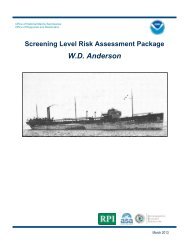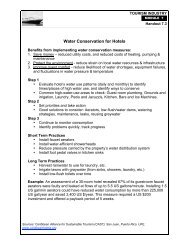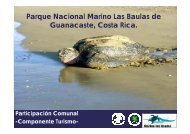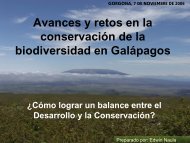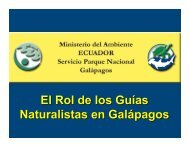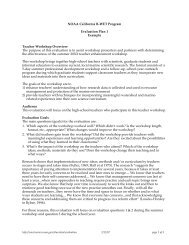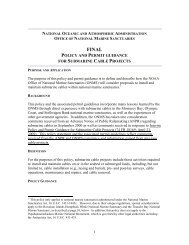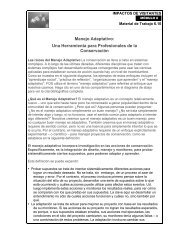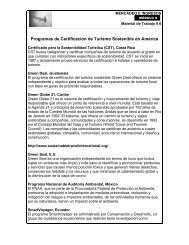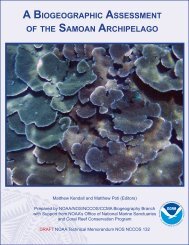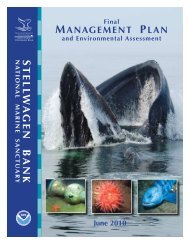new brochure on seabirds - National Marine Sanctuaries - NOAA
new brochure on seabirds - National Marine Sanctuaries - NOAA
new brochure on seabirds - National Marine Sanctuaries - NOAA
You also want an ePaper? Increase the reach of your titles
YUMPU automatically turns print PDFs into web optimized ePapers that Google loves.
For the Birds…<br />
How Nati<strong>on</strong>al <strong>Marine</strong> <strong>Sanctuaries</strong> Benefit Seabirds<br />
Comm<strong>on</strong> Murres<br />
<br />
<strong>NOAA</strong>’s Office of Nati<strong>on</strong>al <strong>Marine</strong><br />
<strong>Sanctuaries</strong> serves as the trustee for a<br />
system of 14 marine protected areas<br />
encompassing more than 170,000<br />
square miles of America’s ocean and<br />
Great Lakes waters. Within the Nati<strong>on</strong>al<br />
<strong>Marine</strong> Sanctuary System’s protected<br />
waters, <strong>seabirds</strong>, including shorebirds,<br />
play an important role in the ecosystem,<br />
and in many cases, serve as indicators<br />
of ocean health within the nati<strong>on</strong>al<br />
marine sanctuaries.<br />
<strong>Sanctuaries</strong> invest hundreds of<br />
thousands of dollars annually in<br />
research, citizen science, educati<strong>on</strong> and<br />
protecti<strong>on</strong> for <strong>seabirds</strong>. <strong>Sanctuaries</strong> also<br />
receive thousands of dollars annually<br />
from oil spill damage assessment funds,<br />
restorati<strong>on</strong> funds, and funding from<br />
foundati<strong>on</strong>s to protect and restore<br />
<strong>seabirds</strong>.<br />
Brett Hartl/PRBO<br />
Western Gulls<br />
R<strong>on</strong> LeValley
The West Coast<br />
Tufted Puffin <br />
Nati<strong>on</strong>al marine sanctuaries <strong>on</strong> the West Coast protect the largest<br />
c<strong>on</strong>centrati<strong>on</strong> of breeding <strong>seabirds</strong> in the c<strong>on</strong>tiguous United States,<br />
and provide feeding habitat for thousands of <strong>seabirds</strong> and wintering<br />
birds <strong>on</strong> the Pacific Flyway. All five nati<strong>on</strong>al marine sanctuaries <strong>on</strong> the<br />
West Coast have numerous programs that result in the restorati<strong>on</strong><br />
and protecti<strong>on</strong> of <strong>seabirds</strong>.<br />
Sophie Webb<br />
Oiled Eared Grebe<br />
Bob Dang/CDFG<br />
Protecting Nesting Sites and Rookeries<br />
All five nati<strong>on</strong>al marine sanctuaries <strong>on</strong> the West Coast have regulati<strong>on</strong>s that benefit<br />
<strong>seabirds</strong>, such as prohibiti<strong>on</strong>s <strong>on</strong> oil and gas development and dumping oil, trash or<br />
plastic in the sanctuary, which can harm <strong>seabirds</strong>. More specifically, the sanctuaries<br />
also include regulati<strong>on</strong>s that prohibit low-flying aircraft that can cause <strong>seabirds</strong> to<br />
flush off their nests, kicking eggs into the ocean or leaving young chicks vulnerable to<br />
predators. Working closely with state managers, sanctuary staff helped develop<br />
avoidance areas for vessels around seven key seabird rookeries in Gulf of the<br />
Farall<strong>on</strong>es and M<strong>on</strong>terey Bay nati<strong>on</strong>al marine sanctuaries.<br />
Changing Behaviors of Those Who Can Harm Birds<br />
A l<strong>on</strong>g-term investment in <strong>seabirds</strong>, with funding from the Command and Luckenbach Trustee Councils that will<br />
exceed $7 milli<strong>on</strong> over a 25-year period, has resulted in the creati<strong>on</strong> of the California Seabird Protecti<strong>on</strong> Network,<br />
spearheaded by Gulf of the Farall<strong>on</strong>es Nati<strong>on</strong>al <strong>Marine</strong> Sanctuary in cooperati<strong>on</strong> with M<strong>on</strong>terey Bay Nati<strong>on</strong>al<br />
<strong>Marine</strong> Sanctuary and other state and federal agencies, and n<strong>on</strong>-governmental organizati<strong>on</strong>s. The Network<br />
improves the survival and recruitment of seabird col<strong>on</strong>ies by reducing human disturbance through three pr<strong>on</strong>gs –<br />
seabird m<strong>on</strong>itoring, regulatory and enforcement initiatives, and educati<strong>on</strong> and outreach. Accomplishments to date<br />
include:<br />
1) Increasing ocean-user awareness of the potential adverse impacts surrounding human-seabird interacti<strong>on</strong>s<br />
while offering safe methods of observing <strong>seabirds</strong> during recreati<strong>on</strong>al or commercial activities.<br />
2) Fostering informati<strong>on</strong> exchange at key events and venues, such as associati<strong>on</strong> meetings, c<strong>on</strong>ferences, air<br />
and boat shows, and ecotourism vendors.<br />
3) Raising awareness of decisi<strong>on</strong> makers (federal, state and local agencies and commissi<strong>on</strong>s) of the threats<br />
that human disturbance poses to breeding seabird col<strong>on</strong>ies and the best methods to reduce and eliminate<br />
these disturbances.<br />
4) Leading the effort to coordinate all agencies resp<strong>on</strong>sible for enforcing regulati<strong>on</strong>s that help to protect<br />
<strong>seabirds</strong> by reviewing regulatory approaches, developing an enforcement strategy, determining current and<br />
future enforcement needs and creating a patrol guide to ensure laws that protect <strong>seabirds</strong> are enforced.<br />
C<strong>on</strong>ducting Research <strong>on</strong> Seabirds as Indicators of Ecosystem Health<br />
The Applied California Current Ecosystem Studies (ACCESS) c<strong>on</strong>ducted by Gulf<br />
of the Farall<strong>on</strong>es and Cordell Bank nati<strong>on</strong>al marine sanctuaries, in partnership<br />
with PRBO C<strong>on</strong>servati<strong>on</strong> Science, c<strong>on</strong>duct at-sea m<strong>on</strong>itoring for <strong>seabirds</strong> and<br />
marine mammals in the c<strong>on</strong>text of physical oceanographic processes. The data<br />
serves five purposes:<br />
1) Wildlife – improve c<strong>on</strong>servati<strong>on</strong> of top predators and their food webs.<br />
2) Ocean z<strong>on</strong>ing – guide human uses to provide protecti<strong>on</strong> of the ecosystem.<br />
3) Climate change – document effects of envir<strong>on</strong>mental change <strong>on</strong> the<br />
ecosystem.<br />
4) Fish populati<strong>on</strong>s – c<strong>on</strong>tribute to ecosystem-based management<br />
approaches.<br />
5) Water quality – assess ecosystem effects of freshwater outflow.<br />
Pige<strong>on</strong> Guillemots <br />
R<strong>on</strong> LeValley<br />
2
Public Educati<strong>on</strong> through Exhibits and the Internet<br />
Channel Islands, M<strong>on</strong>terey Bay and Gulf of the Farall<strong>on</strong>es nati<strong>on</strong>al marine sanctuaries all partner with<br />
other agencies and instituti<strong>on</strong>s to display exhibits that feature <strong>seabirds</strong>. These include:<br />
1) A <str<strong>on</strong>g>new</str<strong>on</strong>g> exhibit featuring unique <strong>seabirds</strong> and the protecti<strong>on</strong>s in place for these species at the<br />
Channel Islands Boating Center;<br />
2) An interactive exhibit where public awareness is raised about <strong>seabirds</strong> as part of the land and sea<br />
c<strong>on</strong>necti<strong>on</strong> at the Coastal Discovery Center in San Sime<strong>on</strong>; and<br />
3) An exhibit featuring local <strong>seabirds</strong> at the Point Reyes Bear Valley Visitor Center.<br />
Cordell Bank Nati<strong>on</strong>al <strong>Marine</strong> Sanctuary hosts an <strong>on</strong>line interactive seabird poster that educates about<br />
<strong>seabirds</strong> that live and feed <strong>on</strong> Cordell Bank.<br />
Educating America’s Youth<br />
Brown Pelican <br />
• Grades K-12: Ocean Science and NOW (North<br />
Olympic Watershed) Science Program – Olympic<br />
Coast Nati<strong>on</strong>al <strong>Marine</strong> Sanctuary educates students<br />
about marine debris, ocean currents and black-footed<br />
albatross.<br />
• Grades 3-5: The Seabird Shuttle – Gulf of the<br />
Farall<strong>on</strong>es Nati<strong>on</strong>al <strong>Marine</strong> Sanctuary has both inschool<br />
and after school programs that teach students<br />
about local <strong>seabirds</strong>, adaptati<strong>on</strong>s of marine birds, and<br />
ways that students can have a positive effect <strong>on</strong> the<br />
ocean and its ecosystems.<br />
Steve L<strong>on</strong>hart <br />
• Grades 6-12: Winged Ambassadors – Cordell Bank<br />
Nati<strong>on</strong>al <strong>Marine</strong> Sanctuary and Papahānaumokuākea<br />
<strong>Marine</strong> Nati<strong>on</strong>al M<strong>on</strong>ument both offer a student ocean<br />
literacy program through the eyes of albatross, in<br />
which students learn about how <strong>seabirds</strong> are affected<br />
by ocean plastic polluti<strong>on</strong> and fisheries bycatch.<br />
C<strong>on</strong>ducting Citizen Science, Improving Oil Spill Resp<strong>on</strong>se and Restorati<strong>on</strong><br />
The three West Coast sanctuaries that are adjacent to the mainland provide baseline data <strong>on</strong><br />
dead birds <strong>on</strong> beaches through a network of volunteer expert surveyors. These programs assist<br />
sanctuary management in the early detecti<strong>on</strong> of natural and human-caused envir<strong>on</strong>mental events,<br />
and train volunteers who can resp<strong>on</strong>d during an oil spill.<br />
1) Beach Watch, established 1993, in Gulf of the Farall<strong>on</strong>es Nati<strong>on</strong>al <strong>Marine</strong> Sanctuary: 120<br />
volunteers c<strong>on</strong>tribute more than 5000 hours of survey time annually. Data from Beach Watch<br />
have supported natural resources damage assessment and provided scaling for restorati<strong>on</strong><br />
projects resulting in more than $50,000,000 in settlement funds used for greater protecti<strong>on</strong> of<br />
<strong>seabirds</strong>, marsh lands and lost recreati<strong>on</strong>al-uses from five oil spills.<br />
2) Beach COMBERS (Coastal Ocean Mammal / Bird Educati<strong>on</strong> and Research Surveys),<br />
established 1997, in M<strong>on</strong>terey Bay Nati<strong>on</strong>al <strong>Marine</strong> Sanctuary: Volunteers sample selected<br />
secti<strong>on</strong>s of beach during the first week of each m<strong>on</strong>th at low tide for dead marine birds and<br />
mammals. Data from Beach COMBERS have been used by fishery managers to adjust set gill<br />
net fisheries to eliminate bycatch of <strong>seabirds</strong>.<br />
3) COASST (Coastal Observati<strong>on</strong> and Seabird Study Team), established 1998, in Olympic<br />
Coast Nati<strong>on</strong>al <strong>Marine</strong> Sanctuary in partnership with the University of Washingt<strong>on</strong>: Volunteers<br />
m<strong>on</strong>itor local beaches and record beached <strong>seabirds</strong>.<br />
3
The Southeast/Gulf of Mexico<br />
The Florida Keys are a haven for more than 250 species of birds. Great<br />
white her<strong>on</strong>s, brown pelicans, magnificent frigate birds, white-crowned<br />
pige<strong>on</strong>s and many other birds comm<strong>on</strong>ly roost or nest <strong>on</strong> low-lying<br />
mangrove islands found in the backcountry of Florida Keys Nati<strong>on</strong>al <strong>Marine</strong><br />
Sanctuary. Roseate spo<strong>on</strong>bills and other waders also feed in the shallow<br />
waters surrounding the mangrove islands.<br />
Reddish Egret <br />
The z<strong>on</strong>ing plan for the Florida Keys sanctuary includes 27 Wildlife<br />
Management Areas (WMAs) which minimize disturbance to sensitive or<br />
endangered wildlife and their habitats, such as bird nesting, resting and<br />
feeding areas. WMAs provide opportunities in the shallow mangrove areas<br />
for public use while protecting wildlife. These areas include no-motor z<strong>on</strong>es,<br />
idle speed <strong>on</strong>ly/no wake z<strong>on</strong>es, and buffer and closed z<strong>on</strong>es, which directly<br />
benefit breeding or roosting birds. The sanctuary spends about $150,000<br />
per year <strong>on</strong> enforcement, educati<strong>on</strong>, marine debris removal and buoy<br />
maintenance in the WMAs.<br />
The Northeast<br />
Nancy Diersing <br />
Wils<strong>on</strong>'s Storm-petrel <br />
Stellwagen Bank Nati<strong>on</strong>al <strong>Marine</strong> Sanctuary, in collaborati<strong>on</strong> with Mass<br />
Audub<strong>on</strong>, is in the midst of the first full year of a pi<strong>on</strong>eering study of<br />
<strong>seabirds</strong> in the sanctuary. Named the Stellwagen Sanctuary Seabird<br />
Stewards Program (S4), the project Goal is to: 1) systematically collect<br />
baseline data <strong>on</strong> <strong>seabirds</strong> to compare occurrence and abundance over<br />
time; 2) train a group of volunteer observers to join scientists; and 3)<br />
educate the public about <strong>seabirds</strong> and c<strong>on</strong>nect residents with their<br />
sanctuary.<br />
Ari Friedlaender <br />
The resulting data will further understanding of seabird populati<strong>on</strong>s within<br />
the sanctuary, detect impacts <strong>on</strong> local ecosystems, and be used as a<br />
barometer for other changes in the envir<strong>on</strong>ment. The sanctuary managers<br />
are collaborating with other agencies to share data and evaluate activities<br />
that may threaten <strong>seabirds</strong> in the sanctuary and al<strong>on</strong>g the entire East<br />
Coast. This program is being developed as a l<strong>on</strong>g-term m<strong>on</strong>itoring<br />
program similar to West Coast citizen science programs, and currently<br />
partners are raising funds to achieve this goal.<br />
http://sanctuaries.noaa.gov<br />
The missi<strong>on</strong> of <strong>NOAA</strong>’s nati<strong>on</strong>al<br />
marine sanctuaries is to c<strong>on</strong>serve,<br />
protect and enhance the<br />
biodiversity, ecological integrity<br />
and cultural legacy of these<br />
special underwater places. The<br />
protecti<strong>on</strong> of <strong>seabirds</strong> is a critical<br />
element of the Nati<strong>on</strong>al <strong>Marine</strong><br />
Sanctuary System.<br />
4



